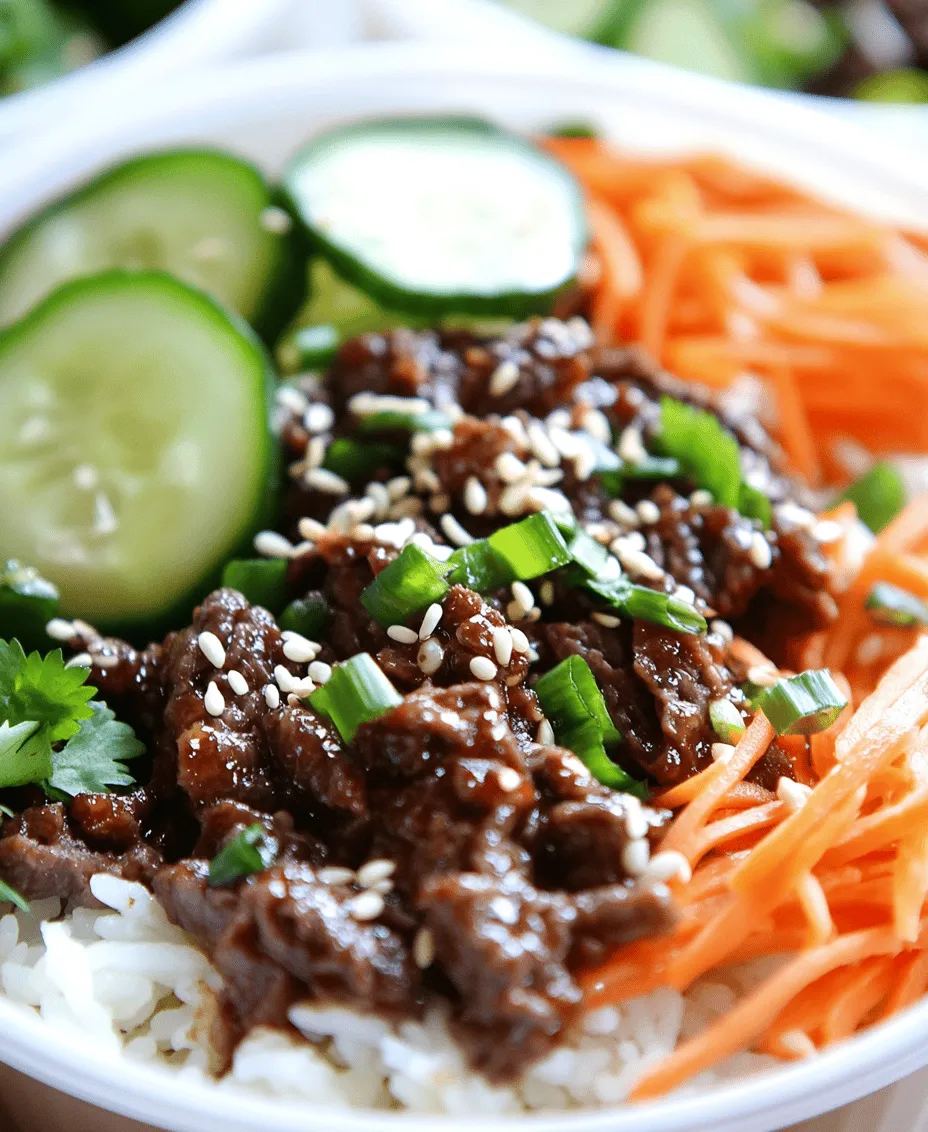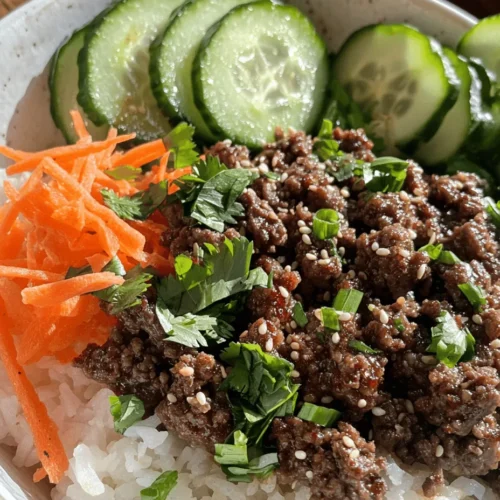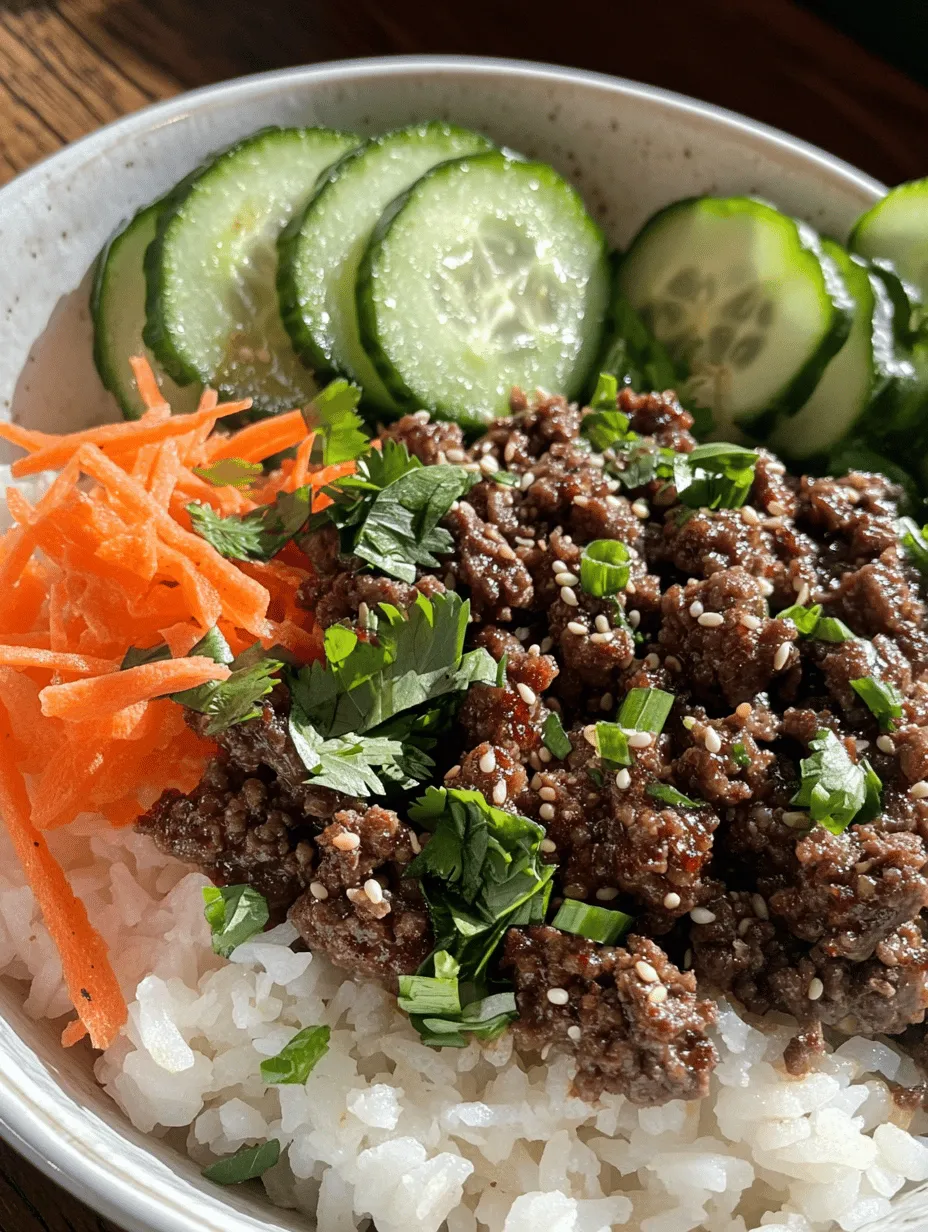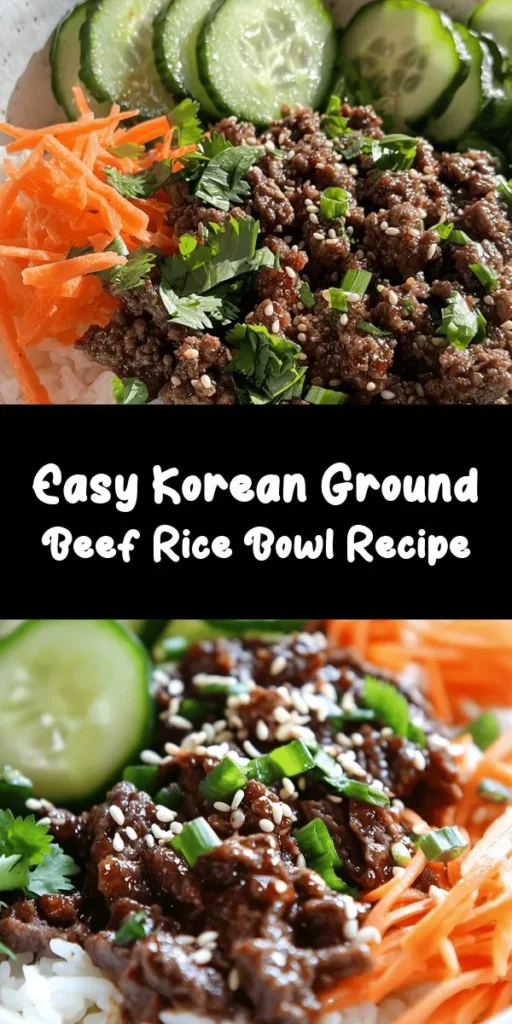Introduction
Korean cuisine has taken the culinary world by storm, enchanting taste buds far and wide with its vibrant flavors and diverse dishes. With its unique blend of sweet, savory, spicy, and umami, Korean food offers a delightful experience that is both comforting and exciting. Among the many delectable offerings, the Korean Ground Beef Bowl stands out as a quick, flavorful, and satisfying meal option that is perfect for busy weeknights or casual gatherings.
This dish is not just about convenience; it embodies the essence of Korean cooking through its emphasis on balancing flavors and textures. The harmony between the tender, savory ground beef, the crunch of fresh vegetables, and the aromatic blend of seasonings creates a delightful bowl that is both nutritious and filling. Whether you are a seasoned home cook or a beginner in the kitchen, this recipe is approachable, making it an excellent introduction to Korean culinary traditions.
Understanding Korean Ground Beef Bowl
The Korean Ground Beef Bowl, also known as “Bulgogi Bowl,” is a modern twist on the classic Korean dish known as bulgogi, which translates to “fire meat.” Traditionally, bulgogi consists of marinated beef that is grilled or stir-fried, often served with rice and various side dishes. The ground beef version simplifies the cooking process while retaining the rich flavors and essence of the original dish.
Culturally, this dish holds significance as it represents the communal spirit of Korean dining, where meals are enjoyed together, accompanied by an array of banchan (side dishes). The Korean Ground Beef Bowl is versatile, allowing for personalization based on dietary preferences and ingredient availability, making it a staple in many households.
Key Ingredients
At the heart of the Korean Ground Beef Bowl are several key ingredients that contribute to its unique flavor profile and nutritional benefits:
1. Ground Beef: The main protein component of the dish, ground beef offers a rich source of iron and protein. For optimal flavor, it’s recommended to use ground beef with a fat content of around 80-85%, which ensures the meat remains juicy and tender during cooking.
2. Aromatics: Garlic and ginger are essential in Korean cooking, providing depth and warmth to the dish. Their bold flavors help to elevate the overall taste of the bowl.
3. Soy Sauce: This umami-rich condiment is pivotal in bringing the dish together. Regular soy sauce adds saltiness and depth, while low-sodium options are available for those watching their salt intake.
4. Brown Sugar: A crucial ingredient that balances the savory and sweet elements of the dish, brown sugar enhances the overall flavor, making it more complex and satisfying.
5. Sesame Oil: Known for its distinct nutty flavor, sesame oil is a staple in Asian cuisine. It adds a unique aroma and richness to the dish that is hard to replicate with other oils.
6. Rice Vinegar: A splash of rice vinegar brightens the flavors, cutting through the richness of the beef and adding a refreshing tang.
7. Red Pepper Flakes: For those who enjoy a bit of heat, red pepper flakes can be adjusted to taste, making the dish customizable based on personal preference.
8. Scallions and Carrots: These fresh vegetables not only add color and crunch but also provide additional nutritional benefits, such as vitamins and antioxidants.
9. Optional Toppings: To elevate the dish further, optional toppings like sesame seeds, fresh cilantro, and spicy kimchi can be added, enhancing both flavor and texture.
Ingredients Breakdown
Let’s dive deeper into the key ingredients that make the Korean Ground Beef Bowl a standout dish.
Ground Beef
The foundation of this dish is ground beef, which is not only flavorful but also versatile. When selecting ground beef, choose a blend with 80-85% lean meat to ensure that it retains moisture during cooking. This fat content allows the beef to develop a rich flavor while remaining tender. Additionally, ground beef is an excellent source of protein, iron, and essential nutrients, making it a wholesome choice for your meals.
Aromatics: Garlic and Ginger
Garlic and ginger are integral to many Korean dishes, providing aromatic depth and a touch of heat. Freshly minced garlic adds a pungent kick, while ginger contributes a warm, spicy undertone. Together, they create a fragrant base that enhances the overall flavor profile of the ground beef. The combination of these aromatics can transform an ordinary dish into something extraordinary, making it essential in this recipe.
Soy Sauce
Soy sauce is a cornerstone of Korean cooking, and its role in the Korean Ground Beef Bowl cannot be overstated. It serves as the primary seasoning, imparting a savory umami flavor that is characteristic of Korean cuisine. When shopping for soy sauce, you can choose between regular and low-sodium options. Regular soy sauce tends to be saltier and more robust, while low-sodium varieties are gentler on the palate without sacrificing flavor.
Brown Sugar
Brown sugar plays a crucial role in balancing the savory notes of the soy sauce and the richness of the beef. Its subtle sweetness rounds out the flavors, creating a well-balanced dish that is both satisfying and delicious. Using brown sugar rather than white sugar adds a touch of complexity, as the molasses content in brown sugar contributes a deeper flavor.
Sesame Oil
Sesame oil is a beloved ingredient in Asian cuisine, known for its distinctive nutty aroma and taste. Adding a drizzle of sesame oil at the end of cooking enhances the dish’s flavor and aroma, bringing a gourmet touch to your Korean Ground Beef Bowl. This oil is rich in healthy fats and antioxidants, making it a beneficial addition to your meals.
Rice Vinegar
A splash of rice vinegar brightens the dish, adding a slight tang that contrasts beautifully with the savory elements. It not only enhances the flavors but also helps to cleanse the palate, making each bite refreshing. Rice vinegar is milder than other types of vinegar, making it an ideal choice for this dish.
Red Pepper Flakes
For those who enjoy a bit of heat, red pepper flakes are an easy way to customize the spice level of the Korean Ground Beef Bowl. Start with a small amount and adjust according to your heat preference. This flexibility allows everyone to enjoy the dish according to their taste.
Scallions and Carrots
Fresh vegetables like scallions and carrots add not only color but also texture to the dish. Scallions bring a mild onion flavor, while carrots provide a crunchy contrast to the tender beef. Both ingredients are packed with vitamins and antioxidants, enhancing the dish’s nutritional value.
Optional Toppings
To personalize your Korean Ground Beef Bowl, consider adding optional toppings. Sesame seeds provide a delightful crunch and a nutty flavor, while fresh cilantro adds a burst of freshness. Spicy kimchi can elevate the dish with its tangy heat, offering a traditional Korean touch that complements the flavors beautifully.
Preparation Steps
Now that we have explored the ingredients that make up the Korean Ground Beef Bowl, let’s move on to the preparation steps. This dish is designed to be quick and straightforward, making it perfect for any home cook.
1. Prep the Ingredients: Start by gathering all your ingredients and prepping them. Finely mince the garlic and ginger, slice the scallions, and julienne the carrots. Having everything ready to go will streamline the cooking process.
2. Cook the Beef: In a large skillet or wok, heat a tablespoon of oil over medium-high heat. Add the ground beef, breaking it up with a spatula. Cook until the beef is browned and cooked through, about 5-7 minutes. Ensure to drain any excess grease if necessary.
3. Add the Aromatics: Once the beef is cooked, push it to one side of the skillet and add the minced garlic and ginger to the empty side. Sauté them for about 30 seconds until fragrant, then mix them into the beef.
4. Season the Mixture: Pour in the soy sauce, brown sugar, sesame oil, rice vinegar, and red pepper flakes. Stir the mixture well, ensuring the beef is evenly coated in the sauce. Allow it to simmer for a few minutes, letting the flavors meld together.
5. Incorporate the Vegetables: Add the sliced carrots and scallions to the skillet, stirring them into the beef mixture. Cook for an additional 2-3 minutes until the vegetables are slightly tender but still retain their crunch.
6. Taste and Adjust: Before serving, taste the mixture and adjust the seasoning as necessary. You can add more soy sauce for saltiness, brown sugar for sweetness, or red pepper flakes for heat, depending on your preferences.
7. Serve: Once everything is well combined and heated through, serve the Korean Ground Beef Bowl over a bed of steamed rice or quinoa. Garnish with optional toppings like sesame seeds, fresh cilantro, or kimchi for an added burst of flavor.
With these preparation steps, you’re well on your way to creating a delicious Korean Ground Beef Bowl that is sure to impress family and friends alike. The combination of flavors and textures will transport you to the bustling streets of Korea, where this dish is cherished and celebrated.
Stay tuned for the next part of this article, where we’ll dive deeper into tips for achieving the best results and answering some common questions about this beloved dish.

Step-by-Step Guide to Cooking the Korean Ground Beef Bowl
Creating the perfect Korean Ground Beef Bowl requires attention to detail and a few essential steps to ensure that each component shines. Follow this step-by-step guide to achieve a delicious and satisfying meal that is both easy to prepare and packed with flavor.
Cooking the Ground Beef: Tips for Achieving the Perfect Browning
1. Select the Right Beef: Opt for ground beef with a fat content of around 80/20 for the best flavor and moisture. Leaner beef can lead to a dry outcome.
2. Preheat Your Pan: Use a large skillet or wok and heat it over medium-high heat. A well-heated pan ensures that the beef browns evenly and develops a nice sear.
3. Avoid Overcrowding: When adding the beef to the pan, do not overcrowd it. This can cause the meat to steam rather than sear. If you are making a larger batch, cook the beef in two separate batches.
4. Let It Sizzle: Allow the beef to sit undisturbed for the first few minutes. This will help it brown better. Once you see that it has started to brown, break it up with a spatula and continue cooking until no pink remains.
5. Season Wisely: As the beef cooks, season it lightly with salt. This will help to enhance the natural flavors of the meat without overpowering it.
Adding Aromatics: Timing and Techniques for Best Flavor Extraction
1. Onions and Garlic: After the beef is browned, push it to one side of the pan and add diced onions. Cook until translucent, then add minced garlic. Garlic burns quickly, so only cook it for about 30 seconds to a minute until fragrant.
2. Ginger for a Kick: Fresh ginger adds a wonderful warmth to the dish. Add it just after the garlic, allowing it to cook for an additional 30 seconds to release its oils and flavor.
3. Stir to Combine: Once the aromatics are fragrant, mix them with the beef. This ensures that the flavors meld beautifully.
Creating the Sauce: How to Balance Flavors Effectively
1. Key Ingredients: The sauce typically includes soy sauce, brown sugar, sesame oil, and gochujang (Korean chili paste).
2. Combine and Heat: In a small bowl, whisk together ¼ cup soy sauce, 2 tablespoons brown sugar, 1 tablespoon sesame oil, and 1 tablespoon gochujang. Adjust the gochujang based on your spice preference.
3. Incorporate the Sauce: Pour the sauce over the beef and aromatics in the pan. Stir well to coat all ingredients. Allow it to simmer for an additional 2-3 minutes, letting the sauce thicken slightly and infuse the beef with flavor.
Incorporating Vegetables: Maintaining Texture and Freshness
1. Choose the Right Veggies: Common choices include bell peppers, carrots, and green onions. These not only add color but also a crunch that contrasts well with the tender beef.
2. Timing is Key: Add the vegetables to the pan right after the sauce has been incorporated. This will allow them to cook just enough to remain crisp while absorbing some of the sauce’s flavors.
3. Toss Gently: Stir-fry the mixture for about 3-4 minutes until the vegetables are tender-crisp, ensuring they maintain a vibrant color and appealing texture.
Assembling the Bowl: Presentation Tips for an Appealing Meal
1. Base Layer: Begin with a generous serving of fluffy jasmine rice at the bottom of each bowl. The rice serves as a great base for soaking up the savory sauce.
2. Add the Beef and Veggies: Spoon the Korean ground beef and vegetable mixture over the rice, allowing the colors to shine through.
3. Garnish for Appeal: Top with sliced green onions, sesame seeds, and a drizzle of additional sesame oil if desired. These finishing touches not only enhance the visual appeal but also add layers of flavor.
Serving Suggestions
Traditional Accompaniments: The Role of Jasmine Rice and Kimchi
No Korean meal is complete without the comforting presence of jasmine rice. Its fragrant and slightly sticky texture pairs perfectly with the flavorful beef. Additionally, serve a side of kimchi to add a tangy, spicy element that complements the dish beautifully.
Creative Variations: Alternative Grains or Vegetable Sides
For those looking to mix things up, consider using quinoa, brown rice, or cauliflower rice as a base instead of traditional jasmine rice. Each alternative offers its own unique flavor profile and nutritional benefits. You can also serve with sautéed bok choy or steamed broccoli for a more vegetable-forward approach.
Ideal Pairings: Beverages That Complement the Dish
To create a well-rounded meal, consider pairing your Korean Ground Beef Bowl with a refreshing beverage. Traditional options include Korean barley tea or soju. For non-alcoholic choices, a cold glass of iced green tea or a fruity Asian soda can elevate the dining experience.
Flavor Profile Analysis
Discussion of the Balance Between Savory, Sweet, and Spicy
The beauty of the Korean Ground Beef Bowl lies in its harmonious balance of flavors. The savory notes from the soy sauce are complemented by the sweetness of brown sugar, while gochujang adds a mild heat. This trifecta creates a well-rounded taste that is both comforting and satisfying.
Textural Contrasts: The Role of Crunchy Vegetables Against the Tender Beef
Each bite of the Korean Ground Beef Bowl offers a delightful contrast in textures. The tender, juicy beef sits alongside crunchy vegetables, providing a satisfying bite that keeps the dish interesting and dynamic.
How the Dish Embodies the Essence of Korean Comfort Food
Korean cuisine often emphasizes comforting, hearty meals that bring people together. The Korean Ground Beef Bowl encapsulates this ethos with its rich flavors and nourishing ingredients, making it a go-to comfort food for many.
Nutritional Insights
Breakdown of Calories and Macronutrients Per Serving
A typical serving of the Korean Ground Beef Bowl (including jasmine rice and vegetables) contains approximately:
– Calories: 500-600
– Protein: 25-30 grams
– Carbohydrates: 60-70 grams
– Fat: 20-25 grams
This balanced profile makes it a satisfying meal that can fuel your day.
Health Benefits of the Main Ingredients
Ground beef is a rich source of protein, essential for muscle repair and growth. Vegetables add vital vitamins and minerals, while the inclusion of sesame oil provides healthy fats that are beneficial for heart health.
Considerations for Dietary Restrictions (Gluten-Free, Low-Carb Options)
For those with gluten sensitivities, gluten-free soy sauce can be used without compromising flavor. Additionally, swapping out jasmine rice for cauliflower rice can significantly lower the carb count, making this dish suitable for a low-carb diet.
Conclusion
The Korean Ground Beef Bowl is more than just a meal; it’s an exploration of flavors and textures that showcases the best of Korean cuisine. Its versatility allows for various adaptations, ensuring that it can be enjoyed by everyone, regardless of dietary preferences.
Encouraging readers to explore Korean flavors in their everyday cooking can open up a world of culinary delights that are both accessible and rewarding. The joy of preparing and sharing this dish lies not only in its deliciousness but also in the connections it fosters around the dinner table. So, roll up your sleeves and dive into this delightful recipe that promises to bring warmth and comfort to your home.



